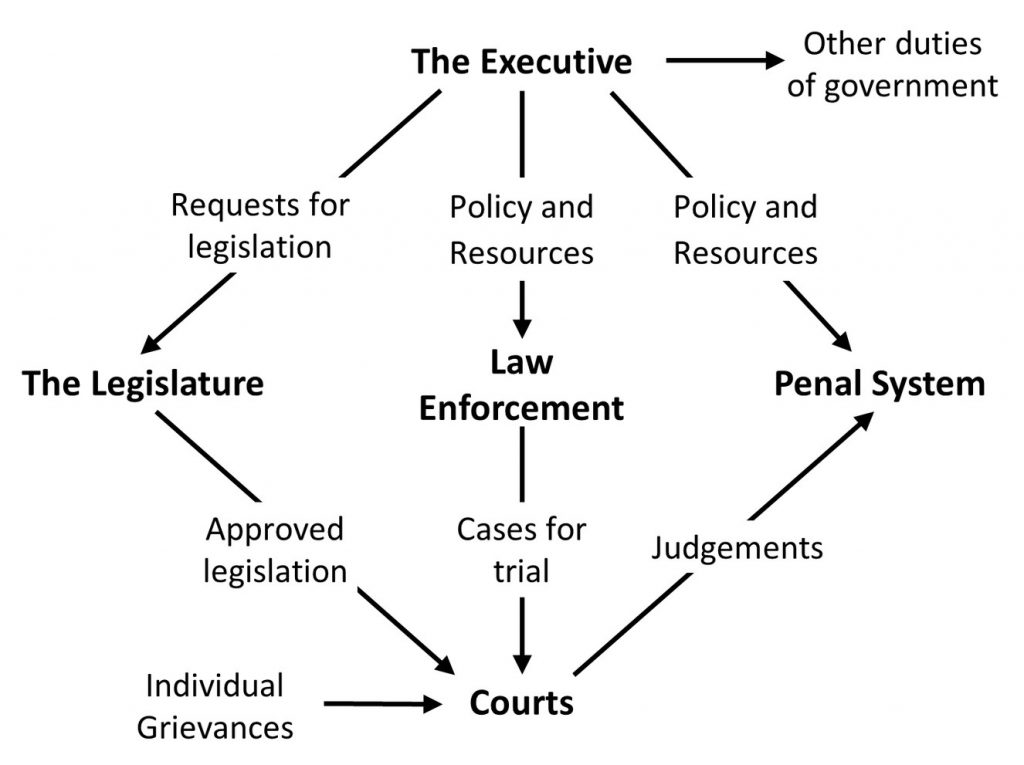5.1.3 Relationships of Legal Powers
The relationships of legal powers: between separate elements of the legal system and with the Executive (the government or Administration).
The Legal Dimension of governance makes and enforces rules which ensure that people comply with agreed behavioural standards; it includes the following institutions:
● The term ‘legislature’ is used to refer to the institutions, such as the American Congress and the British Parliament, which are responsible for creating, maintaining and authorising the rules which govern those aspects of behaviour of people and organisations for which the power of the law is deemed to be appropriate. H.L.A. Hart referred to these as “primary rules” in Chapter 5 of his book, The Concept of Law; they include local by-laws, administrative regulations and national laws. He distinguished them from “secondary rules” such as national Constitutions that confer powers.
● Law enforcement is typically the responsibility of a police force which attempts to prevent crime, to detect those crimes that are committed, and to bring the criminals to justice.
● The courts are responsible for determining whether or not the law has been broken and for deciding how those who have broken it will be penalised.
● The penal system includes prisons and other corrective mechanisms, including rehabilitation.
The relationships of legal powers within a legal system, and their relationship with the government (the ‘executive’), can be illustrated:

These relationships are governed by what Hart called “secondary rules”. The structure of the legal system, and some of the problems which it now faces, are examined in subsequent sections of this chapter.
The Legal Dimension is used to complement and strengthen the other dimensions of governance:
● It can be used to promulgate and enforce some aspects of the regulation of the Economic Dimension (3.3.1).
● A legislature can control the funds available to a government, thereby constraining the scope of government spend (3.2.3).
● It is used to add an element of coercion to the behavioural rules which people apply to each other in the Moral Dimension, including many aspects of the enforcement of agreed rights (4.2.4.2). The relationship between law and morality is a contentious topic, as examined in the next section.
● Constitutions and constitutional conventions, which place legal limits on the powers of politicians and constitutional monarchs, define the political and legal systems. They can prevent authorities from abusing their powers. Both the legislature and the judiciary usually have some degree of independence from government control, under what is known as a ‘separation of powers’ (5.2.8).
● Legal powers provide the support of State authority to protect people and to reduce the need for them to protect themselves. The State has to decide how much resource to put into crime prevention, for example, as compared to the degree to which it relies upon people to take precautions – which, in this book, are classified as Self-Protection (7.2.3).
Each dimension in this book is treated separately so, for example, the Economic Dimension includes the analysis of how regulations affect the economy, but this chapter on the Legal Dimension focuses upon how rules are agreed and enforced if they are given the coercive powers of the law.
This page is intended to form part of Edition 4 of the Patterns of Power series of books. An archived copy of it is held at https://www.patternsofpower.org/edition04/513a.htm.